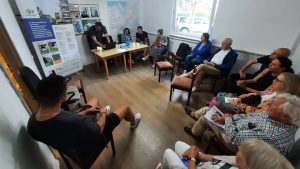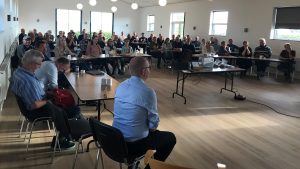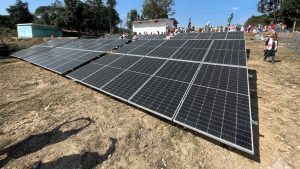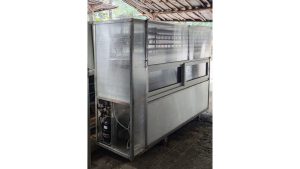This eBook explores how the SUSTENANCE project, led by Aalborg University, advances carbon-neutral communities by integrating sustainable energy systems.
The H2020 SUSTENANCE project has developed sustainable energy systems to create carbon-neutral energy communities. Coordinated by Aalborg University in Denmark, this project involved 21 partners from three EU countries and India.

The focus was on integrating local renewable energy sources and efficient energy solutions across electricity, heat, water, waste, and transportation infrastructures.
The project included demonstration activities in Denmark, the Netherlands, Poland, and India, showcasing innovative energy solutions tailored to local needs.
By promoting energy autarky and decarbonized systems, SUSTENANCE has enhanced the quality of life, reduced energy poverty, and supported socio-economic development in both urban and rural areas.
One of the goals of the SUSTENANCE project was to promote ideas for user engagement and the set up technical solutions. To be able to do so and replicate the findings, the SUSTENANCE project has developed a compiled education material for the public. The idea behind the material, is to explain some of the main developed ideas in a less technical manner, so it can be understood by layman persons or students, so they can engage in the development.
This e-book is based on this developed educational material and gives the content in short form. For more detailed explanations please refer to education material at our home-page. https://h2020sustenance.eu/results/edu-materials/

Role of citizens in local energy areas in the energy transition (Frans Coenen, Associate professor, University of Twente)
A main aspect realized in the SUSTENANCE project is the importance of the citizens as players in the energy transition. They are end-users of the technology innovations set up during the project, and if this technology is not adapted to the way the citizens will be able to utilize and understand it, it will never get the intended utilization in the local energy area. This will also indirectly influence their total energy consumption if they apply energy-efficient appliances and equipment. Therefore, the technology has to be developed in cooperation with the citizens.
Citizens can influence the energy transition in a democracy by voting for political parties and policies that promote renewable energy. They can also act as economic market players by choosing to buy renewable energy or invest in their own production, such as solar panels, or in renewable energy projects like solar or wind farms. Additionally, they can contribute to decarbonization through green electrification of heating and mobility by investing in batteries, heat-pumps, and electric vehicles (EVs).

Citizens can also collaborate in the energy transition by joining local energy communities, which are groups of people who generate, share, and manage their own energy. These communities play a crucial role in decentralized energy systems, allowing citizens to deploy small-scale renewables and storage, complementing grid-scale electricity decarbonization. Decentralized energy systems can help reduce emissions, increase energy security, and lessen the need to reinforce grids.
The European Union has introduced two new definitions of local energy communities. When translating these to national rules, the common characteristics are that they are meant to be open and voluntary and combine non-commercial aims with environmental and social community objectives. Ownership and control are reserved for the citizens, local authorities and smaller businesses, with a particular case being cooperatives. The cooperatives have economic participation of members, autonomy, independence and concern for the community. The local energy communities can, on top of this, include energy generation, storage, energy distribution and energy sharing under a set of shared obligations with an explicit legal provision. In practice, many other citizen communities fulfil the function of formal energy communities. For instance, village citizens councils, farmer organizations or associations of homeowners, for whom organizing renewable energy generation and energy use is a new goal next to the original purpose of the community.



Meetings with citizens in India, Poland and Denmark
Flexibility provision in power systems – potential and advantages (Rakesh Sinah, Assistant professor, Birgitte Bak-Jensen Professor, Aalborg University)
Flexibility in power systems refers to the ability to change the power consumption of different kinds of demands and production to always ensure that the power production and consumption match each other in real-time. This is necessary to keep the stability of the power grid. With the high penetration of renewable energy from wind turbines and solar power, power production will fluctuate more in the future in relation to weather conditions. Therefore, there is also a need for higher flexibility provision to counteract this varying power production. At the same time, flexibility provision can also be used for better utilization of the existing grid infrastructure by performing peak-shaving, which means that you move some of the demand to low-peak periods from high-peak periods to ensure enough capacity for the grid.
To attain flexibility, the electricity market is seen as a key driver since the market can handle flexibility provision and ensure the import/export of energy between countries or local energy areas. The customers can act according to daily variations in the electricity prices, where high prices are seen in the peak periods (typically in the late afternoon and beginning of the evening), and low prices are related to the low-consumption periods (typically during the night).
Since individual customers, as such, cannot directly act on the market, they normally get their prices via aggregators, who also can act on behalf of aggregated values, for instance, for local energy communities.
The flexibility provision can be achieved by, for instance, shifting the operation in time from dishwashers, washing machines, dryers, heat-pumps, electric vehicle charging, and use of energy storage (electrical or thermal storage). For example, an electric vehicle can be charged at night during the low price period, whereas a heat-pump can be run during the daytime if you have your own photo-voltaic power production, and then the heat can be stored in the heat storage.
Some of the advantages of the flexible power provision are, first of all, the ability to accommodate a higher share of renewable energy production. Further, if you are performing peak-shaving mitigating high-peak periods, you also reduce the power loss in the electrical grid and can also delay reinforcement of the grid.


Smart charging of electrical vehicles (Gerwin Hoogsteen, Assistant professor, University of Twente)
With the high integration of electric vehicles, which is seen as a comfortable and sustainable solution for future private transportation, we need a good solution for their charging. A lot of energy is required to fully charge a car for a certain range – for example, 385 km equals 70 kWh. This amount of energy is equal to the weekly electricity consumption of a normal European household for their normal consumption besides heating and car charging.
Most electrical grids are not designed to provide this high power consumption by cars. The electricity grid will be overloaded if too many cars are charging at the same time. Such an overload means that the grid does not have the capacity to transport all the electricity, and as a result, circuit breakers will trip, causing a local blackout.
Therefore, in the SUSTENANCE project, we have developed smart charging, where local controllers tell when the different chargers are allowed to operate and with which amount to prevent grid overloading. This means that it can take a little longer time to have your car charged.
During the SUSTENANCE project, the University of Twente developed a smart charging app. The design criteria are that the car is charged before a certain time (departure time) and that you, as a user, can provide the expected energy required for your next trip. In this way, the smart charging system can automatically decide which car is to be charged at which time to ensure everyone’s comfort.


Only in special circumstances would there be problems in giving the best service to everyone. Usually, cars are only in use 5% of the time, and for the rest of the time, they are parked either at home or at work. This means that they are very flexible to support the grid. In return, customers are rewarded with a lower energy bill and often a more sustainably charged car. A car that is still sufficiently recharged for your next trip.
Microgrids for rural villages in India (Deepika Chhetija, Senior research fellow, Soudipan Maity, Senior research fellow, Milind V Rane, Professor, Ananthu Krishnan, Junior Research Fellow, Indian Institute of Technology Bombay)
In India, several villages are still facing the problem that it is uneconomical to expand the main grid to some of the remote regions in India, and 15% of the population is still devoid of access to electricity or will have electricity with low voltage, flickers, limited time of access and other power quality problems. In India, many microgrids are to be installed, and in the SUSTENANCE project, two microgrids have been developed in the villages of Borakhai in the Cachar district in the state of Assam and Barubeda in Seraikal Kharsawan in the state of Jharkhand. The main focus is to make energy sustainable by using wind and solar power. The system has to be operated in a smart way so the demand from individual components is prioritized, depending on the actual situation at the sites, since not all of the installed equipment can be operated at the same time. This means that the system will schedule when the different units can run via an energy management system.
In the SUSTENANCE project, the development heads towards “energy islands” or “integrated community energy systems”, where the focus is not only on the electricity system, but also other aspects like local transportation in the form of e-rickshaws, heating and cooling, water pumping and energy storages. In the two villages, photo-voltaic systems are set up and supplemented with wind turbine systems for power generation. The system is equipped with battery energy storage, so energy can be stored during the day when the sun is shining and then used, for instance, in the evenings or at night for lightning.

As a part of the SUSTENANCE project, a low-speed micro wind turbine generator has been developed. This wind turbine is based on a small diameter vertical rotor, which is aided by static stator blades that direct and accelerate the wind towards the rotor blades since there is normally only limited wind speed in the area. The wind turbines can supplement the power generated by the photo-voltaic system, especially at night and in the monsoon period when the Sun is limited.

Multi-utility heat-pump for rural application (Milind V. Rane, Professor, Ananthu Krishnan, Junior research fellow, Indian Institute of Technology Bombay)
The rural areas in India are often reliant on agriculture. However, in many cases, they face persistent wastage in relation to their production due to inadequate management of the products after harvesting. In this relation, the SUSTENANCE project has developed a multi-utility heat-pump for the drying and cooling of agricultural products. The reason is that this will enhance the quality and lifetime of the products produced. For instance, drying machines will reduce moisture in agricultural products, meaning longer shelf life and market value. Further, improved short-term storage for fresh products can reduce transportation costs and empower farmers to participate in bulk sales, ensuring better possibilities for economic resilience and stability.
The multi-utility heat-pump device is made as prototypes in two different versions. It can heat the unit to dry up to 45°C. At the same time, water heating from 30°C up to 50°C can be used continuously as long as the compressor is running. The units can also be used as a chiller to precool fruits and vegetables to remove the field heat before bringing the products to the market. In combination with an ice-bank storage inside the cold box, the units can also be used to preserve milk at low-temperature ranges from 3°C to 6 °C. The provision of cold water is also a possibility, with cooling temperatures from 30°C to 15 °C.


The main components of the units are:
- A condenser dryer, with the purpose of drying the agro-products using the condenser heat
- An evaporator cold box for storage of milk or other commodities
- A hot water outlet in the form of a tube-tube heat exchanger which can perform the water heating
- Cold water outlet for water chilling
- A compressor
Click here to access and download the full eBook for free.
 This project has received funding from the European Union’s Horizon 2020 research and innovation programme under grant agreement No 101022587, and the Department of Science and Technology (DST), Government of India under the SUSTENANCE project. Any results of this project reflect only this consortium’s view and funding agencies and the European Commission are not responsible for any use that may be made of the information it contains.
This project has received funding from the European Union’s Horizon 2020 research and innovation programme under grant agreement No 101022587, and the Department of Science and Technology (DST), Government of India under the SUSTENANCE project. Any results of this project reflect only this consortium’s view and funding agencies and the European Commission are not responsible for any use that may be made of the information it contains.


